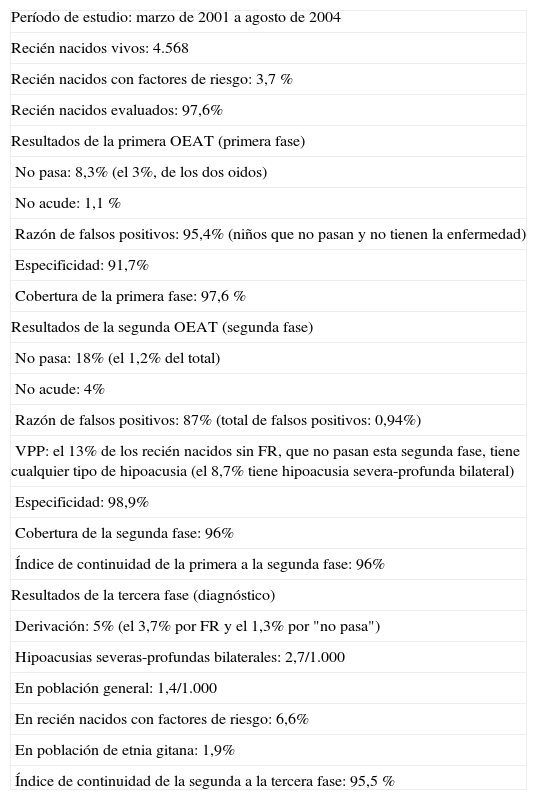Presentamos los resultados de aplicar durante 42 meses un programa de detección precoz universal de la hipoacusia neonatal. Nuestro objetivo ha consistido en diagnosticar y tratar todas las hipoacusias permanentes unilaterales o bilaterales ≥ 40 dB nHL.
MétodosLa estrategia de detección consta de 2 fases de cribado con otoemisiones acústicas transitorias (OEAT) y una fase de diagnóstico con potenciales evocados auditivos del tronco cerebral (PEATC). Los PEATC se realizaron tanto a los que “no pasaban” el cribado con OEAT como a los neonatos con factores de riesgo de hipoacusia.
ResultadosDe los 4.568 recién nacidos (RN) vivos, hemos evaluado al 97,6 %. Un 3,7 % de los nacidos presentaba factores de riesgo de hipoacusia. El 91,7 % de neonatos “pasó” la primera OEAT en ambos oídos, y tras la segunda sólo se derivó a la fase de diagnóstico al 1,3 %. Hemos detectado 2,7 hipoacusias severas-profundas bilaterales/1.000.
ConclusionesLa finalidad de este programa reside en la aplicación precoz del tratamiento adecuado. Aunque resulta posible alcanzar los objetivos de cribado y diagnóstico de la hipoacusia neonatal, es mucho más complicada la fase de intervención, pues depende de diferentes disciplinas que deben actuar coordinadamente y múltiples factores ambientales y familiares difíciles de controlar. La efectividad terapéutica sigue siendo nuestro reto y el motivo de discusión para justificar plenamente los programas de detección precoz de la hipoacusia congénita.
We present the results from applying over a period of three and a half years a universal newborn hearing screening programme aimed at the early detection of hearing loss. Our goal has been to diagnose and treat all unilateral or bilateral permanent hearing losses ≥40 dB nHL.
MethodsThe detection strategy consists of two screening phases with transient evoked otoacoustic emissions (TEOAE) and one diagnostic phase with auditory brainstem responses (ABR). ABR tests were performed on newborns “not passing” the TEOAE screening, as well as those with risk factors for hearing loss.
ResultsOf 4568 live newborns (NB), we evaluated 97.6 %. Of these, 3.7 % presented risk factors for hearing loss. The first TEOAE was “passed” in both ears by 91.7 % of the newborns; after the second TEOAE, only 1.3 % of cases were referred to the diagnostic phase. We detected 2.7/1000 cases of severe/profound bilateral hearing loss.
ConclusionsThis programme was designed for early application of appropriate treatment. Although it is possible to reach the objectives of screening and diagnosis of newborn hearing loss, the intervention stage is much more complicated. This is because intervention depends on different disciplines that must act in co-ordination, as well as multiple environmental and family factors that are difficult to control. Therapeutic effectiveness still remains our challenge and a motive for discussion in fully justifying early congenital hearing loss screening programmes.
Artículo
Comprando el artículo el PDF del mismo podrá ser descargado
Precio 19,34 €
Comprar ahora






